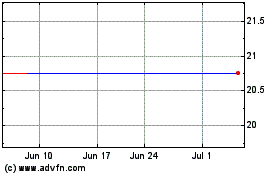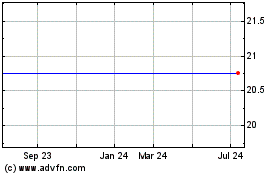Mexico Awards Wholesale Mobile Network License to Altá n Group
November 17 2016 - 3:50PM
Dow Jones News
MEXICO CITY—The Mexican government awarded a license to develop
a multibillion-dollar wholesale mobile network to a group formed by
several investment funds and the World Bank's private-sector arm, a
capital-intensive project seen as crucial for Mexico's ambitious
plan to expand internet access.
The Communication and Transport Ministry on Thursday granted
network development and operating rights to Altá n, a group led by
Spanish telecommunications businessman Eugenio Galdó n, an
infrastructure fund managed by a unit of Morgan Stanley Investment
Management and the China-Mexico Fund, which is run by the IFC Asset
Management Company.
The wholesale network, which will act as a carrier-of-carriers
providing mobile broadband capacity to operators, will use spectrum
freed up by last year's switch-over from analog to digital
television signals.
Investment in the project is expected to surpass $7 billion to
reach more than 92% of Mexico´ s population.
The concession is for 20 years, and can be renewed for a further
20. Altá n said it expects the network to start operating in March
2018.
The project, which the government says will increase the number
of Mexicans with access to wireless internet and lower costs, is
seen by market watchers as a highly risky venture that would
require extensive investment to meet uncertain demand.
The bidding process was questioned by U.S.-based Rivada
Networks, which was disqualified because it didn't provide the
required financial guarantees when it submitted its technical offer
on Oct. 20, leaving Altá n as the sole bidder.
Rivada said the process favored its competitor and that it is
suing to have its bid reinstated. The ministry and Altá n said the
process was transparent and complied with regulations.
Altá n said the new network will enable access to the most
advanced technologies and ensure "service in areas where
traditional operators either do not reach at present, or where
providing to these areas is not profitable."
The new wholesale network will also level the playing field in
the broadband and telecommunications market and attract foreign
direct investment, according to the ministry. But some experts say
it won't provide services to final users and it is unlikely to
generate strong demand from virtual operators that would lease
network capacity.
"In a way, you are creating a segmented monopoly because it
takes a portion of the spectrum and it becomes the sole player
using these resources," said Ernesto Piedras, head of The
Competitive Intelligence Unit, a Mexico City consultancy.
Axtel SAB, a unit of conglomerate Alfa SAB, said the shared
network has the potential to transform the country's information
technology and telecommunications ecosystem. The company, which has
a small nonvoting stake in the consortium, said it plans to add
mobile to its corporate and retail service offerings, while
exploring opportunities in other markets and services in
Mexico.
But market participants doubt the project will be profitable
enough as local networks overlap.
"Investment would go to coverage requirements that are almost
identical to the one that we have right now," said Francisco Gil Dí
az, Mexico's former finance minister and a director of Telefó nica
Mexico. The unit of Spain's Telefó nica SA and its two chief local
rivals—Amé rica Mó vil SAB, AT&T Inc.—have invested billions of
dollars in their own high-speed networks at a time when global
telecommunications markets are consolidating networks.
Amé rica Mó vil is Mexico's biggest mobile operator with 72
million subscribers, followed by Telefó nica with 26 million and
AT&T with more than 10 million. Mobile virtual network
operators have another 895,000 subscribers.
"The spots with significant telecommunications traffic are
mostly covered, there are no dead spots," Mr. Gil Dí az added.
AT&T said it is continuing with its $3 billion investment to
expand its high-speed Mexican network. "We'll continue to monitor
this project as we move forward with our plans in Mexico; if the
[shared network] has coverage in an area where we don't, we would
certainly consider using it," the U.S. company added.
Amé rica Mó vil declined to comment.
Write to Anthony Harrup at anthony.harrup@wsj.com
(END) Dow Jones Newswires
November 17, 2016 15:35 ET (20:35 GMT)
Copyright (c) 2016 Dow Jones & Company, Inc.
America Movil SAB de CV (NYSE:AMOV)
Historical Stock Chart
From Mar 2024 to Apr 2024

America Movil SAB de CV (NYSE:AMOV)
Historical Stock Chart
From Apr 2023 to Apr 2024
